![]()
![]()
![]()
Use LEFT and RIGHT arrow keys to navigate between flashcards;
Use UP and DOWN arrow keys to flip the card;
H to show hint;
A reads text to speech;
38 Cards in this Set
- Front
- Back
|
What are the properties of cytokines?
|
1. Small secreted, non-antibody proteins
2. Both cells involved in adaptive and innate immunity produce cytokines 3. Cytokines mediate and regulate immunity, inflammation, and hematopoiesis 4. Produced in response to a stimuli (not stored) 5. Grouped by structures into families |
|
|
T/F
Cytokines are stored in vesicles until they are required |
False
They are created as needed (not stored) |
|
|
T/F
Cytokines produce a relatively slow cellular response |
True
a couple of hours |
|
|
What are four main types of cytokines?
|
§ Lymphokine: made by activated lymphocytes (ex: IL-2)
§ Monokine: made by mononuclear phagocytes § Chemokine: Involved in chemotactic activity (ex: IL-8 § Interleukin: Interaction between leukocytes |
|
|
What type of cytokine is made by activated lymphocytes like IL-2?
|
Lymphokine
|
|
|
What type of cytokine is made by mononuclear phagocytes?
|
Monokines
|
|
|
What type of cytokine is involved in chemotactic activity like IL-8?
|
Chemokines
|
|
|
What type of cytokine is produced from an interaction between leukocytes?
|
Interleukin
|
|
|
What type of signalling do cytokines demonstrate when it is produced by many cell types and act on many cell types?
|
Pleiotropic
|
|
|
What is the term for different cytokines having similar actions?
|
Redundant
|
|
|
What type of profound effect occurs from a defect in the IL-2 receptor?
|
Sever Combined Immunodeficiency
|
|
|
How can cytokines regulate immunity?
|
1. Can induce Tregs
2. Have antiproliferative properties 3. Regulate the synthesis of acute phase proteins following tissue injury, trauma, inflammation and sepsis. 4. TGF can inhibit proliferation of T cells and activation of B cells 5. IL-2 can down regulate T cell production 6. IL-10 can inhibit other cytokine production |
|
|
What will happen if the immune response goes uncontrolled?
|
Collateral damage to tissues
|
|
|
What causes the majority of the damage in an infection?
|
The immune response itself
|
|
|
What is the type of response demonstrated by this: Recognition of antigen in the absence of co-stimulation results in an inability to respond. A T cell requires signals from both the TCR and CD28 for activation. This occurs in the absence of co-stimulatory molecules inactivation. This situation would prevail to tolerize T cells not removed by central tolerance to self antigens expressed on peripheral tissues.
|
Anergy
|
|
|
What is the type of response demonstrated by this: In the absence of an antigen-specific signal (e.g. wrong peptide) there is no effect on the T cell.
|
No Effect
|
|
|
What is the type of response demonstrated by this: Co-reception of both signals, from the surface of a professional APC, activates the T cell to produce IL-2 and its receptor (IL-2R). The cell divides and differentiates into an effector T cell, which no longer requires signal 2 for its effector function.
|
Activation
|
|
|
What is the type of response demonstrated by this: At the termination of the immune response, CTLA-4 replaces CD28 and downregulates T cell function.
|
Downregulation
|
|
|
What are the 4 types of responses to antigens?
|
1. Anergy
2. No effect 3. Activation 4. Downregulation |
|
|
Why is TNF-alpha the most important cytokine?
|
§ Mediator in response to microbes such as LPS.
§ Mediates recruitment of neutrophils and macrophages to the side of inflammation § Stimulates endothelial cells and macrophages to produce chemokines § Potent pyrogen causing fever § Promotes production of acute phase proteins § Prothrombic and promotes leukoyte adhesion and migration. § Modulates hematopoiesis and lymphoyte development. |
|
|
What is the significance of NFkB and STAT proteins?
|
They are transcription factors that modulate immune response
|
|
|
What has the following properties:
1. Dimeric transcription factors 2. Sequestered by inhibitory IkB proteins and retained in cytosol in resting cells 3. Induced by microbial cell components and viruses attaching to receptors like IL-1 and TLR, CD40L, CD4/TCR and UV light |

NFkB
|
|
|
What prevents NFkB transcription factor from being active all the time?
|
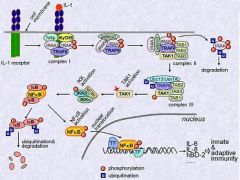
NFkB is sequestered by inhibitory IkB proteins and retained in cytosol in resting cells. Once the inhibitory IkB is removed via phosphorylation, NFkB moves into the nucleus to activate gene expression.
|
|
|
How is signal transduction propagated for NFkB once microbial cell components and viruses attach to receptors like IL-1 and TLR, CD40L, CD4/TCR and UV light?
|

Traf6, MyD88 and IRAK are all attached to the intracellular portion of the receptor. When the cytokine binds, IRAK and Traf6 leave the receptor through some degradation, ubiquination, TAK1 is activated, which phosphorylates IkB which removed it from NFkB and allows it to move into the nucleus.
|
|
|
What does STAT represent?
|
STAT
Signal Transducers and Activators of Transcription |
|
|
What family of tyrosine kinases do STATs require to become active?
|
JAK
|
|
|
Where do non-phosphorylated, monomeric STATs reside?
|
In the cell Cytosol
|
|
|
Where is JAK located?
|
JAK is on the intracellular portion of the transmembrane receptor.
|
|
|
How does STAT signal transduction occur?
|
1. JAK is phosphorylated when something (like IFNgamma) binds the extracellular portion of the receptor
2. This leads to STAT being phosphorylated and activated 3. STAT joins with another STAT 4. These dimers move into the nucleus to act on gene transcription |
|
|
T/F
Cytokine receptors are usually in the form of single receptors. |
False
Cytokine receptors usually form dimers and trimers -- it would be rare to find a single receptor |
|
|
What is the first thing to happen to a cytokine receptor when a cytokine binds to the extracellular component?
|
The intracellular component of the receptor initiates a signal cascade by conformational change when a cytokine binds to the extracellular component. (conformational change can initiate phosphorylation, ubiquitination, active transcription factors,etc.
|
|
|
How many components of TNFr family receptors are present and what do they activate?
|
○ TNFR family of receptors is a trimer and stimulates the activation of the NFkB transcription factor family.
§ Activation of TNFR regulates the expression of genes that can be induced by IL-1R/TLR |
|
|
What are the different types of PAMPs that TLRs detect?
|
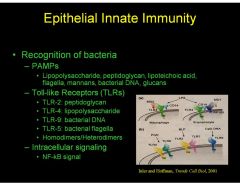
1. LPS
2. Peptidoglycan 3. Lipoteichoic acid 4. Flagella 5. Mannans 6. Bacterial DNA 7. Glucans |
|
|
What TLR detects peptidoglycan?
|
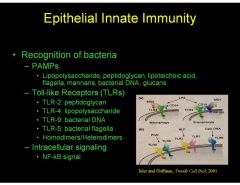
TLR-2
|
|
|
What TLR detects LPS?
|

TLR-4
|
|
|
What TLR detects bacterial DNA?
|
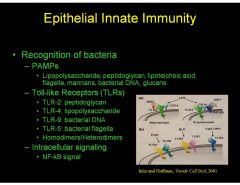
TLR-9
|
|
|
What TLR detects bacterial flagella?
|
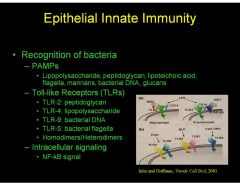
TLR-5
|
|
|
Where are TLRs found?
|
On the inside and outside of all of our cells including epithelial cells
|

